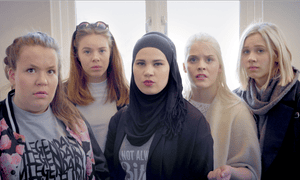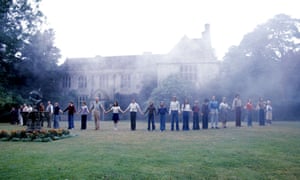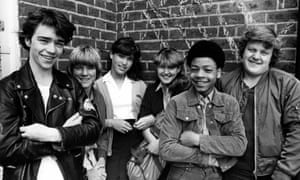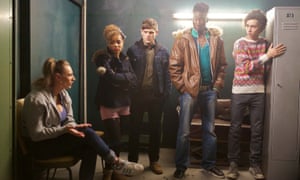Steven Moffat’s 1990s smart-mouthed comedy-drama about kids running a newspaper is the reason thousands of 40-somethings are now journalists. The teens in this show are socially responsible campaigners for truth, rather just self-absorbed or romantically obsessed. Except for Dexter Fletcher’s Spike, a cocky New Yorker who is sent to the Junior Gazette as punishment for delinquency. Lightning sparks between him and Julia Sawalha’s Lynda Day, the nails editor who spouts horny “hold the front page” dialogue like a Fisher-Price Sorkin character. While they drive each other crazy, the show gets on with tackling the issues of the day; drug addiction and death are not stepped around. Most of all, Moffat treated his characters and the audience like adults, which was thrilling, and confidently beat the path that others would follow. JR
Tomorrow People
If, as I did, you became a teenager in the 70s between the miners’ strikes and Chaka Khan’s I’m Every Woman, Thames TV’s The Tomorrow People (1973-1979) was essential viewing. Its telepathic teen posho protagonists saw off aliens and even a balloon invasion while the proto-Muggles of the adult world looked on in awe. Teens like me projectively identified with them as we battled nascent sexuality and the fascist adult hygiene strictures encoded in X Ray Spex Germ-Free Adolescent. True, effects were cheap (unsurprising given each episode cost £5,000) and plots were ludicrous (Hitler was reincarnated as a slug in one episode), but us kids liked the Nietzschean notion that the Tomorrow People were called Homo Superiors while grown-ups were Saps (short for Homo Sapiens, see?). There was a US remake a few years ago, but by then I was a Sap with a mortgage. SJ
There is plenty of teenage TV that I have appreciated as an adult – for the writing, the wit, the characterisation, the relevance – but few shows actually resonated when I was in the target demographic. And none came near JJ Abrams’s back-lit display case for microscopic teenage girldom. Abrams was unafraid to linger – very little ever actually happened – and, crucially, he kept all archness at bay. Rarely has a show been quite as willing to let a kid – Kerri Russell in all her pre-Bond, golden-locked glory as its titular freshman – be her earnest, introspective, late-blooming self. DBS

High school shows are not typically known for their realism, with most trading in cosily familiar tropes with jocks, geeks and cheerleaders all so clearly defined, they might as well be wearing signs around their necks. While that is often the escapist appeal for many, I always hankered for an alternative that managed to reflect the messier aspects of the experience – prioritising specificity over stereotyping. Freaks and Geeks – a one-season wonder from Paul Feig and Judd Apatow – was this very show: an honest, embarrassing, sad, funny, thrillingly well-observed encapsulation of the highs and lows of being a teenager. It struggled to find an audience at the time, understandable given its high-profile network TV slot (it would have lasted far longer in today’s streaming heavy landscape), but has been heaped with praise ever since, securing a home with those whose younger years were also a bit rougher around the edges. BL
It is hard to recall how much of a desert for teenagers British television was when Channel 4 launched in November 1982. The Tube was not a show about teenagers, but it was that rare thing – a show that was indubitably for teenagers. From its time slot – early on a Friday teatime – through to the shambolic presenting of Paula Yates and Jools Holland, it screamed a lack of interest in adult approval. Its messy format – mixing up interviews, comedy, filmed clips and live performances – replicated the teenage attention span, and offered up a world that was not designed for adults to understand (even if they were nodded to in the form of some of the guests). The Tube wasn’t always great, but it was ours. MH
Of course teenagers throughout history have wrangled adolescent angst, but it was Dawson’s Creek, which began in 1998, that interminably excavated it until you felt like telling them all to just pull themselves together. You only understand that with hindsight; as an earnest teenage berk, it was as if Dawson, Joey, Pacey and Jen had reached into your soul and laid it out in perfect dramatic form, against a lovely watery North Carolina backdrop. These were emotionally-literate, frighteningly articulate 15-year-olds who spoke as if they were philosophy academics on a Radio 4 show. They seemed worldly and glamorous, and cerebral while still fuelled by hormones. It provided notable firsts, such as the first gay kiss on US primetime TV, but, for a whole generation of teenagers, it turned introspection and public emoting mainstream. ES

Heartbreak High
In truth, some elements of this early 90s Australian show about a tough Sydney high school have aged about as well as popper pants and those red hats Fred Durst used to wear. Southgate was a cardboard-cut-out angry teacher with a bad home life, while Hartley High’s young new English teacher Christina Milano did veer into white saviour territory at times. But characters like Rivers, Nick, Danielle, Con and Katerina were a rare collection of teenage characters who were well-drawn, complex and actually interesting. Bogdan Drazic is probably the best remembered character and he didn’t even show up until the second half of the fifth season. There were some very bold narrative moves too: killing the main character at the end of the first season isn’t usually encouraged. And the show did “issues” in a no-holds barred manner: drug addiction, teen pregnancy, racism, divorce and domestic violence were all covered. Shot on film to exacting standards, Ada Nicodemou (Katerina) said that when she moved to Home and Away she was stunned that there were no rehearsals and people were expected to cry on cue rather than building up to a “genuine moment”. It’s a cliche to say they don’t make them like that any more, but they really don’t. LB
The granddaddy of US teen drama premiered in 1990 with some of the oldest-looking adolescents since Gerald Campion’s Billy Bunter. But the chemistry between twins Brenda and Brandon Walsh, alcoholic Dylan, adopted Steve, spoilt Kelly, geeky David, virginal Donna and skint, clever clogs Andrea is the main reason this ground-breaking series about rich, troubled teenagers worked so well in its early years. Wealthy kids had problems too; they just drove flash cars to school. Classic storylines included Brenda and Dylan’s split to REM’s Losing My Religion, the Brenda-Dylan-Kelly love triangle, I Choose Me, “Donna Martin graduates!” and the 2000 finale’s big wedding. Even if this Darren Star (Sex and the City) show hadn’t spawned spins-offs and influenced the likes of Dawson’s Creek, Buffy, Party of Five and My So-Called Life, the unforgettable Color Me Badd and Rolling Stones episodes alone are enough to make it legendary. LC
Ryan Murphy became “the most powerful man in TV” as the New Yorker called him recently by showrunning some of the biggest recent shows in television: Glee, Feud, American Horror Story, Nip/Tuck. But he started with the gratuitously myopic and melodramatic teenage comedy-drama Popular. This late 90s show interrogated power dynamics and class privilege at high school and centred around two rival cliques forced together after parents of girls from either gang get engaged. Precipitously cut after only two seasons, Popular featured many of the themes routinely found in teen shows, such as eating disorders, self-esteem and sexuality, but was ultimately preoccupied with the mercurial cache of “popularity”: unpacking the problematic nature of the traits that feed into it. LW
Byker Grove in many ways was the north’s answer to Grange Hill. Set in a youth club in Newcastle, the show started the careers of such Geordies as Donna Air, Jill Halfpenny and, of course, Ant and Dec, who are still arguably the most successful names to ever come out of a CBBC programme. Storylines dealt with issues from homosexuality to sexual relationships and foster homes, many years before Tracy Beaker came along. At its peak in the 90s it was regularly drawing in 5 million viewers twice a week and remains – in my mind – as a marker of a time when the BBC was bold in its approach to youth programming and didn’t patronise them, offering gritty storylines, albeit with some very wooden acting. IA

What does a girl with no friends, a staunch feminist, a closeted gossip-monger and a sarcastic hijabi have in common? In the case of Skam, quite a lot, as characters Eva, Noora, Isak and Sana navigate almost topic you would have covered in PSHE lessons. But aren’t teens just on their phones all the time? Well, yes, which is why the texts, DMs and “grams” released alongside the daily, time-stamped episodes make you feel like you’ve stumbled upon a minute-by-minute retelling of your 15-year-old cousin’s life. Copycat versions in France, Italy, Germany and now a US adaptation prove that not watching Skam makes you, in the words of Sana, “the biggest loser of us all”. GS
For British teenagers living through the grim and grey early 90s, there was nothing more exotic than the US show Saved by the Bell. The delight in this teenage land of jocks and nerds, dances, hanging out in Memphis-styled diners and climbing through each other’s bedroom windows, was tempered with the bitter realisation that your dream of being a Bayside High student was never going to happen. Zack Morris was the scheming charmer with the ability to break the fourth wall, and the humongous mobile phone. Kelly, Jessie and Lisa were the girl gang you wanted to join (you would feel privileged just to be a leotard-clad backing dancer for their band Hot Sundae); hunky AC Slater introduced the intriguing idea of high school wrestling to weedy Brits, but the true star was, of course, supergeek Screech. He was endearing enough but what he really represented was the idea that even the biggest dork might get to hang out with the cool kids. ES
The first three seasons of Iain Morris and Damon Beesley’s show, and the movies, are all on All 4 to mark its 10th anniversary. It’s still rude, crude and oppressively male, but that’s the point, that’s what it’s about. For anyone who has ever been a male teenager, it rang so true. This wasn’t some fantasy coming-of-age with glamorous girls, and loved-up parties. It was the sordid sad reality, of disappointment and lies, also of not really caring and having a laugh along the way. The Inbetweeners captured male adolescence to the point of actually smelling of it. I know. Urgh. It also had some of the best dialogue of any sitcom; Will, Simon, Neil and Jay were, and spoke like, real boys. Well, a bit funnier maybe. The Inbetweeners was – is – hilarious. SW
When the cast of Skins were still watching Peppa Pig there was As If, a Sunday lunchtime show about six teenagers that set a new standard for British youth TV. Like any good early 2000s telly it is gloriously dated, but if you can forgive the boinging noises, experimental camera angles and heady R&B that accompanied any appearance of Sasha – the one black character – it is a teen classic. Its appeal is enhanced by the pioneering Sooz, who not only inspired McFly’s number one hit Five Colours In Her Hair, but portrayed mental health issues and the very realistic struggles of late teens. All punk, sarcasm and piercings; she was a gap-year-haired legend who showed kids it’s OK to not be OK. HV

Children of the Stones
It might have been aimed at teens but Children of the Stones’ complexity, artfulness and general chill factor has made it a touchstone for a generation of now middle-aged hauntologists. Astrophysicist Adam Brake and his son Matthew arrive in the fictional English village of Milbury with Adam intending to research the village’s megalithic stone circle. Matthew, meanwhile, will attend the local school, which is inexplicably full of oddly unassuming child prodigies. Before long, Adam’s research is unfolding in ways that are both revelatory and alarming. It is a wildly ambitious and still genuinely creepy affair, particularly for late afternoon kids’ viewing – imagine an unholy hybrid of Why Don’t You?, The League of Gentlemen and The Wicker Man and you’re somewhere near. PH
Like the most potent of teen love affairs, this short-lived 90s melodrama remains as a visceral, half-remembered episode. But for anyone who came of uncertain age pre-millennially, a love story is exactly what it was. The “so-called” life of 15-year-old Pennsylvania sophomore Angela Chase and those around her broke from the goofy conventions of the teen genre – the mundane coming through as often impossibly bleak. Indeed, the show’s bruising portrayal of crippling inertia, coming-out struggles, alcoholism and the gamut of teen struggles was too emo to survive more than a single season in the conservative world of US network telly, but its legacy speaks beyond itself. Making stars of Clare Danes and Jared Leto, it still overshadows both their subsequent careers – with the “Danes sadface” living on in Homeland to this day. DM
Dubplate drama
It is 2005, everyone’s edges are laid with a toothbrush and Dionne (Shystie) is in the middle of her first set on pirate radio. That is until Titch yanks the mic out of her hand and, in a nasty turn of events, she witnesses a stick-up involving the station manager. But does she escape with the perpetrators? “What happens next is up to you” is the message on the screen. Dubplate Drama is the dramatised version of grime’s first-wave no one thought they needed until Luke Hyams wrote it for the small screen. When the interactive series premiered on Channel 4, the kicker was that half of the cast, from Shystie to Tulisa to Ghetts, were already successful musicians who essentially played themselves. GS
A Different World
This Cosby Show spin-off followed Denise Huxtable (Lisa Bonet on the cusp of being Kravitzed) as she headed off to college. With her 90s dance moves and stylish headbands, Denise was a teenager so cool you didn’t even dare hope you’d be like her. She was the perfect laid back foil to show-stealing sasspot Whitley, the Southern belle who brought the classy one-liners. No teen show is complete without its resident geek, and Denise’s try-hard love interest Dwayne Wayne was a flip-up spec-wearing gem. Sadly, Bonet left after the first season because she was pregnant (with Zoe Kravitz, fact fans) and, according to Bonet’s co-star Debbie Allen, that moral guardian Bill Cosby didn’t think it would be right for Denise to be a single mother. HV

Many questioned whether children would want to come home from school to watch young actors pretending to be students. But Phil Redmond is a genius of popular TV, and revolutionised teen drama through the twice-weekly half hours set in a north London comprehensive school. As with JK Rowling’s later Hogwarts, the fictional academy achieved the trick of sharing some elements with the viewer’s own school (brutal PE teachers, swots and bullies) but being, in other ways, glamorously and strangely dramatic. As with Blue Peter, each generation had its own special figures: mine were Todd Carty’s Tucker Jenkins, Susan Tully’s Suzanne Ross, and Michael Cronin’s Mr “Bullet” Baxter. The treatment of then sensitive issues such as sex and drugs helped youth telly to grow up. Redmond graduated to Brookside and then Hollyoaks, which became his third TV show to run for two decades or more, while several of the cast (Carty, Tully, Letitia Dean) moved on to big-TV in EastEnders, making Grange Hill, in more than one way, an influential teaching institution. ML
King Cinder
In 1977, Britain was a dirty, desperate, rocky place, one of small towns and infighting rock tribes. King Cinder was the six-part series that gave teens the lowdown on the world into which they were coming of age. It starred Peter Duncan, later of Blue Peter, as a speedway rider – the sport was hugely popular in the 70s, part of the zeitgeist – and Lesley “Mum” Manville as his girlfriend. They did battle in the fictional seaside town of Barton with a vicious gang of extortionists, including the once-ubiquitous Daniel Abineri as a Hell’s Angel. The series ended with a thrilling car chase and fatal crash involving a red Austin Maxi, the acme of hatchbacks in 1977. It is crying out for a DVD reissue. DS
Like all great teen TV, Laguna Beach felt thrillingly modern when it debuted in 2004. Billed as a “real” counterpoint to Fox’s smash hit The OC, it was one of the very first structured reality shows, fusing documentary with glossy teen drama as it chronicled the alliances of a gaggle of primped and moneyed Californian high schoolers. It was the kind of thing you would have a hard time explaining to your parents, but to teenagers the show’s repetitive, and often quite banal, drama was both aspirational and hugely relatable. With storylines largely comprised of tentative romances and petty squabbles, Laguna Beach captured the exhilarating minutiae of adolescence in a way that densely-plotted and relentlessly dramatic teen shows never could. RA

Misfits takes a high-concept idea – teens with Asbos develop superpowers as the result of a freak storm, The Breakfast Club meets Heroes – and grounds it in the minutiae of actual teenage life. Trapped together in a grim community service centre on the outskirts of London, the characters argue, avoid work, smoke, get drunk, cop off with each other, and resist every display of adult authority. It’s just that arguments wind up with Nathan waking up in a coffin, drunken sex leads to Curtis impregnating himself, and anti-authoritarianism manifests as multiple dead probation workers. The cast included Joe Gilgun, Game of Thrones’s Iwan Rheon and Lauren Socha and Utopia’s Nathan Stewart-Jarrett, while one plotline involved trying to go back in time and kill Hitler. But the show never lost its core thesis: being a teenager switches between stultifyingly boring and completely bewildering, and sometimes not even the ability to make yourself invisible helps. MP
As rites-of-passage go, the dawning realisation that you are a chosen one destined to protect the world from supernatural menace is going to do it. Joss Whedon’s ultimate allegory of the misfit has earned a rightful place in history as one of the ultimate genre franchises, while at the same time delivering one of the spottest-on portrayals of teen life ever to grace the screen – wooden stakes and all. And coming from Whedon, it comes built in with the biggest of hearts and the sharpest of dialogues. Buffy Summers died twice, slayed through seven seasons and even aced a regularly re-enacted musical episode. And, 15 years on from its climax, the tentacles of comic books, spin-off media and fan fiction means the Buffyverse remains remarkably undead. DM
A killer cast (starring both Jesse Plemons and Michael B Jordan), a high-school sports premise built to tug on every heart string known to man and a theme tune as expansive as the Texan skies its story played out under. Kicking off with a dreamy drop-you-in-the-deep-end pilot, it went on to run the full gamut of underage drama, from abuse and abandonment to abortion and addiction. If its primetime-friendly approach neatly straddled Hollywood liberalism and the conservatism its red-state setting dictated, it did so with just the right mix of humour, heart and downright poetry. Mostly, it had, in Kyle Chandler and Connie Britton’s Coach Taylor and Tammy – his wife and the school’s head – every messed up kid’s surrogate parents. This was the show that made being a teenager – and perhaps also having a teenager – feel safe. DBS
Did we miss anything? Have your say in the comment below